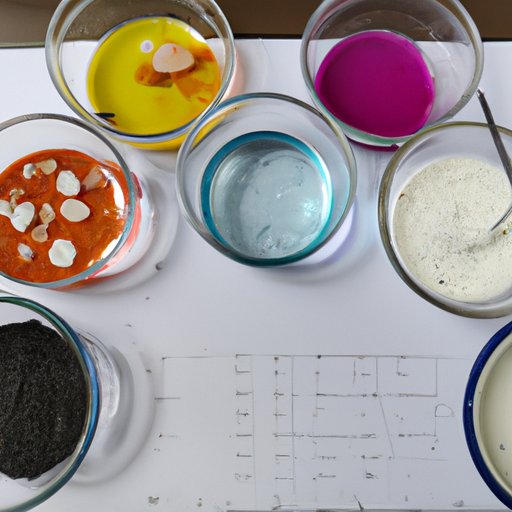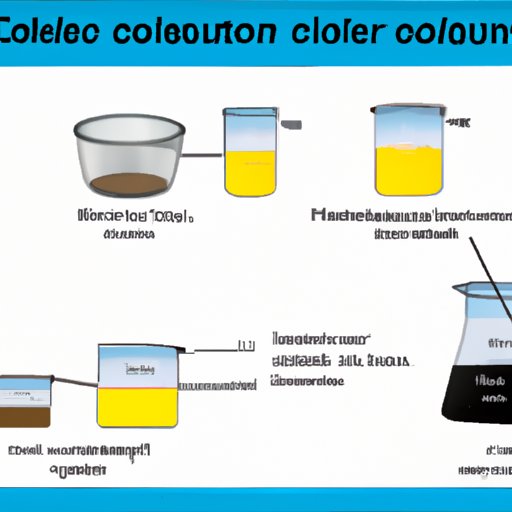Introduction
Mixtures are an important concept in science. But what exactly is a mixture? A mixture is a combination of two or more substances that are physically mixed together but do not chemically combine. This article will explore the different types of mixtures, their properties, and their uses in everyday life.

An Overview of Mixtures in Science
Mixtures are a fundamental part of science. They can be found in many everyday items, from air to concrete. Understanding the different types of mixtures and their properties is essential for scientists and engineers alike.
What are Mixtures?
A mixture is a combination of two or more substances that are physically mixed together but do not chemically combine. The components of a mixture can be separated using physical methods such as filtration, distillation, or evaporation. Mixtures can be either homogeneous or heterogeneous. In a homogeneous mixture, all components are evenly distributed throughout the mixture. In a heterogeneous mixture, the components are not evenly distributed.
Different Types of Mixtures
There are three main types of mixtures: suspensions, colloids, and solutions. Suspensions are heterogeneous mixtures in which the components are large enough to be visible to the naked eye. Colloids are also heterogeneous mixtures, but the components are small enough to be invisible to the naked eye. Solutions are homogenous mixtures in which the components are so small that they cannot be seen.

Examining Different Types of Mixtures
Homogeneous and Heterogeneous Mixtures
As mentioned earlier, mixtures can be either homogeneous or heterogeneous. Homogeneous mixtures have the same composition throughout. Examples include air, alcohol, and sugar water. Heterogeneous mixtures have different compositions in different parts of the mixture. Examples include soil, oil and vinegar salad dressing, and concrete.
Suspensions, Colloids, Solutions
Suspensions are heterogeneous mixtures in which the components are large enough to be visible to the naked eye. An example is a glass of muddy water. The mud particles are suspended in the water, but they eventually settle to the bottom. Colloids are also heterogeneous mixtures, but the components are small enough to be invisible to the naked eye. An example is fog, which is made up of tiny water droplets suspended in air. Solutions are homogenous mixtures in which the components are so small that they cannot be seen. An example is salt water, which is a mixture of salt and water molecules.
Exploring the Properties of Mixtures
Physical Properties of Mixtures
Mixtures have a variety of physical properties. These properties can vary depending on the composition of the mixture. For example, the boiling point of a mixture is usually lower than the boiling point of the individual components. Other physical properties of mixtures include viscosity, surface tension, density, and solubility.
Chemical Properties of Mixtures
Mixtures also have a variety of chemical properties. These properties depend on the composition of the mixture and the interactions between the components. For example, the reactivity of a mixture depends on the reactivity of the individual components. Other chemical properties of mixtures include reactivity, flammability, and corrosiveness.
The Chemistry Behind Mixtures
Elements and Compounds
Mixtures are composed of elements and compounds. Elements are pure substances that cannot be broken down into simpler substances. Examples include oxygen, carbon, and hydrogen. Compounds are substances that are composed of two or more elements that are chemically combined. Examples include water, salt, and sugar.
Intermolecular Forces in Mixtures
Intermolecular forces are the attractive forces between molecules. These forces are responsible for the physical and chemical properties of mixtures. The strength of these forces depends on the type of molecules present in the mixture. For example, polar molecules tend to have stronger intermolecular forces than nonpolar molecules.
Examples of Common Mixtures
Mixtures can be found in many everyday items. Here are some examples of common mixtures:
Air
Air is a homogeneous mixture of gases, including oxygen, nitrogen, and carbon dioxide.
Water
Water is a homogeneous mixture of hydrogen and oxygen molecules.
Soil
Soil is a heterogeneous mixture of minerals, organic matter, and air.
Concrete
Concrete is a heterogeneous mixture of cement, sand, gravel, and water.

Investigating the Uses of Mixtures in Everyday Life
Household and Industrial Uses
Mixtures are used in a variety of household and industrial applications. For example, paint is a mixture of pigments, binders, and solvents. Motor oil is a mixture of base oils and additives. Batteries are a mixture of chemicals that produce electricity. Soaps and detergents are mixtures of surfactants and other ingredients.
Medicine and Technology
Mixtures are also used in medicine and technology. For example, vaccines are mixtures of antigens and adjuvants. Printing inks are mixtures of dyes and solvents. Adhesives are mixtures of polymers and resins. Microchips are mixtures of metals, semiconductors, and insulators.
Conclusion
Mixtures are an important concept in science. This article has explored the different types of mixtures, their properties, and their uses in everyday life. Mixtures can be homogeneous or heterogeneous, and they can be composed of elements, compounds, or both. Mixtures are used in a variety of household and industrial applications, as well as in medicine and technology. Understanding the concept of mixtures is essential for scientists and engineers alike.
(Note: Is this article not meeting your expectations? Do you have knowledge or insights to share? Unlock new opportunities and expand your reach by joining our authors team. Click Registration to join us and share your expertise with our readers.)
